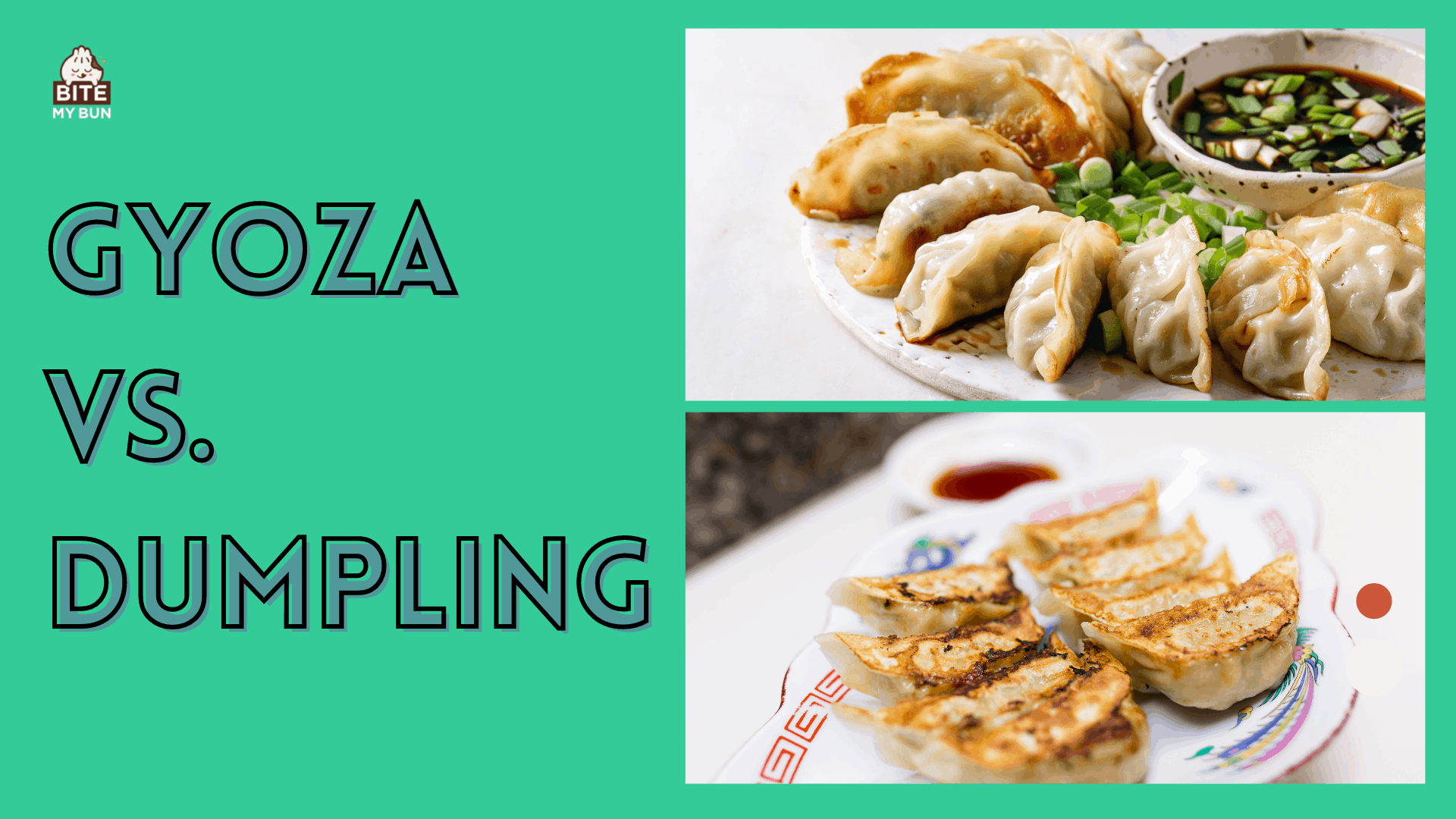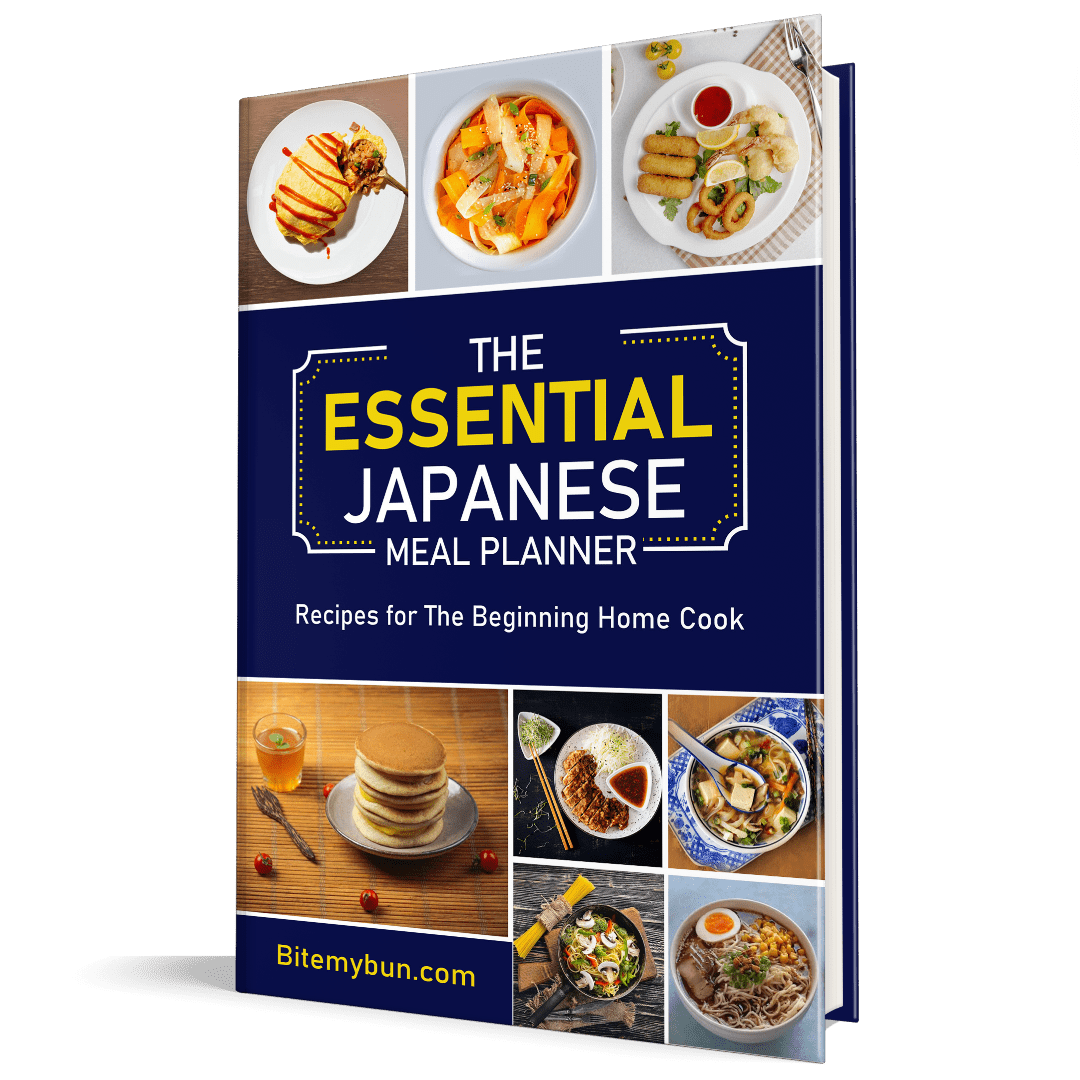Gyoza vs. dumpling: Gyoza is a dumpling, but not all dumplings are gyoza!
If you love dumplings, pierogies, and stuffed pasta, then you’ve probably heard of “gyoza.” It’s one of Japan’s best-known pan-fried dumplings!
Many people think dumplings are 1 specific round dough ball stuffed with meat and vegetables. However, that’s not the case.

Dumplings are a whole food category, and gyoza is a type of dumpling.
Here, let me explain the difference.
The difference between a dumpling and gyoza is that dumplings are a category of dough stuffed with various sweet or savory ingredients like meat and vegetables. Dumplings are most popular in China. Gyoza, however, is a Japanese type of half-moon-shaped steamed and then pan-fried dumplings filled with ground pork and veggies.

Check out our new cookbook
Bitemybun's family recipes with complete meal planner and recipe guide.
Try it out for free with Kindle Unlimited:
Read for freeIn this post we'll cover:
Dumplings and gyoza explained
Dumplings aren’t one specific dish. Rather, the term “dumpling” encompasses a broad range of pieces of dough wrapped around a filling or cooked dough without any filling.
Dumplings are a popular category in Asian cuisine, especially Chinese and Japanese. In terms of flavor, dumplings can be savory or sweet, and common fillings include meat, vegetables, fish, cheese, fruit, or sweet pastes.
Dumplings can be steamed, pan-fried, or deep-fried.
Gyoza, however, is a specific type of Japanese dumpling. It has a half-moon shape, a thin dough wrapper, and is steamed then pan-fried.
Traditional gyoza is filled with minced pork and vegetables like napa cabbage. But these days, gyoza wrappers are filled with all kinds of ingredients like seafood, vegetables, and beef or chicken.
Another one of my favorite dumplings is takoyaki. Find 6 delicious takoyaki recipes here!
What’s the difference between gyoza and dumplings?
Filling
As I mentioned earlier, gyoza is a Japanese type of dumpling. But if we compare gyoza to Chinese dumplings, the main difference is the filling.
While gyoza wrappers are usually filled with ground pork, cabbage, spring onion, minced garlic, and ginger and then are dipped into a soy-based sauce, dumplings can contain a whole variety of ingredients.
Dough/wrapper
As well, gyoza filling is wrapped in a thin wheat flour dough, while some dumplings like Chinese xiao long bao have large, thicker dough dumpling wrappers.
Many of the world’s favorite dumplings are made of wheat flour. However, gyoza is commonly made from pre-fabricated thin wrappers.
The wrappers are quite delicate and a bit harder to fold and mold into shape because of their fine texture.
Shape and cooking method
The shape of gyoza is that of a half-moon with pleated edges, and the dumplings are long but not very big. In fact, gyoza is about a bite or 2 smaller than the average Chinese potsticker or steamed dumpling.
Dumplings come in all shapes, but round and bucket dumplings are most popular. Gyoza-like shapes are also common.
Gyoza wrappers are stuffed, steamed in a bamboo steamer, and then pan-fried in oil for a few minutes until they develops a crispy exterior.
You can also find age-gyoza, which are deep-fried dumplings, and sui-gyoza, which are boiled in water.
Of course, pan or teppan-fried dumplings and deep-fried ones have a fantastic crunchy texture and a soft, tender interior, and they’re extra yummy!
Flavor & how they’re served
The reason that gyoza is considered different from jiaozi (the most similar Chinese dumpling) is that the flavors are more subtle to suit the Japanese palate. Chinese seasonings are often spicy and strong-flavored, whereas the Japanese generally prefer mild foods.
Thus, gyoza is often served with a simple soy sauce dip. Some gyoza sauce recipes indeed call for chili pepper flakes to add some spice, but the most common gyoza dipping sauce is made with rice vinegar, soy sauce, sesame oil, ginger, and a hint of garlic.
Other dumplings are served with chili oil, soy sauce, rice vinegar, or other spicy sauces.
If you don’t have rice vinegar, don’t worry. You can use one of the substitutes I mention through that link!
If you want to know how to make the juiciest pork dumplings, then check out this video:
Origin
Another difference between the 2 is their age and location. Chinese dumplings were invented in Northern China. The dumplings (jiaozi) were invented more than 1,000 years ago.
Compared to jiaozi, gyoza’s a recent or modern invention of the 1940s (World War II) era. Soldiers returning from the war brought back dumpling recipes and modified the fillings to include Japanese spices and flavors.
Chinese vs. Japanese dumplings
Gyoza isn’t quite a uniquely Japanese invention. It was adapted from Chinese jiaozi dumplings.
But instead of a bucket-shaped steamed dumpling with a pork filling, gyoza is half-moon shaped and contains minced pork and cabbage.
Some of the world’s most common dumplings are Chinese.
Usually, Chinese dumplings are called potstickers, and they’re compared to Japanese gyoza because that’s Japan’s most common type of doughy dumpling.
The difference between Chinese and Japanese dumplings (gyoza) is that Chinese potstickers have a thicker dough or wrapper. That’s because the potstickers are usually cooked with steam.
Gyoza has a thinner wrapper so it’s easily fried on a Japanese teppan griddle.
Learn more: 3 main differences between Chinese food vs Japanese food explained
Which dumplings do you love?
All dumpling lovers will understand that each dumpling has a unique flavor profile, texture, and shape.
Sure, they’re all great; but of course, some are just a bit more superior.
It all comes down to preference. Some love them steamed, and some prefer fried dumplings.
If you prefer the crunchy texture of the steamed and fried dough, you’ll love gyoza. But if you want a healthy steamed or boiled dumpling, you might like some of the Chinese dumplings more.
Make sure to try them all!
For more great culinary ideas, here are 43 of the best, most delicious & unusual Asian food to try
Check out our new cookbook
Bitemybun's family recipes with complete meal planner and recipe guide.
Try it out for free with Kindle Unlimited:
Read for freeJoost Nusselder, the founder of Bite My Bun is a content marketer, dad and loves trying out new food with Japanese food at the heart of his passion, and together with his team he's been creating in-depth blog articles since 2016 to help loyal readers with recipes and cooking tips.
